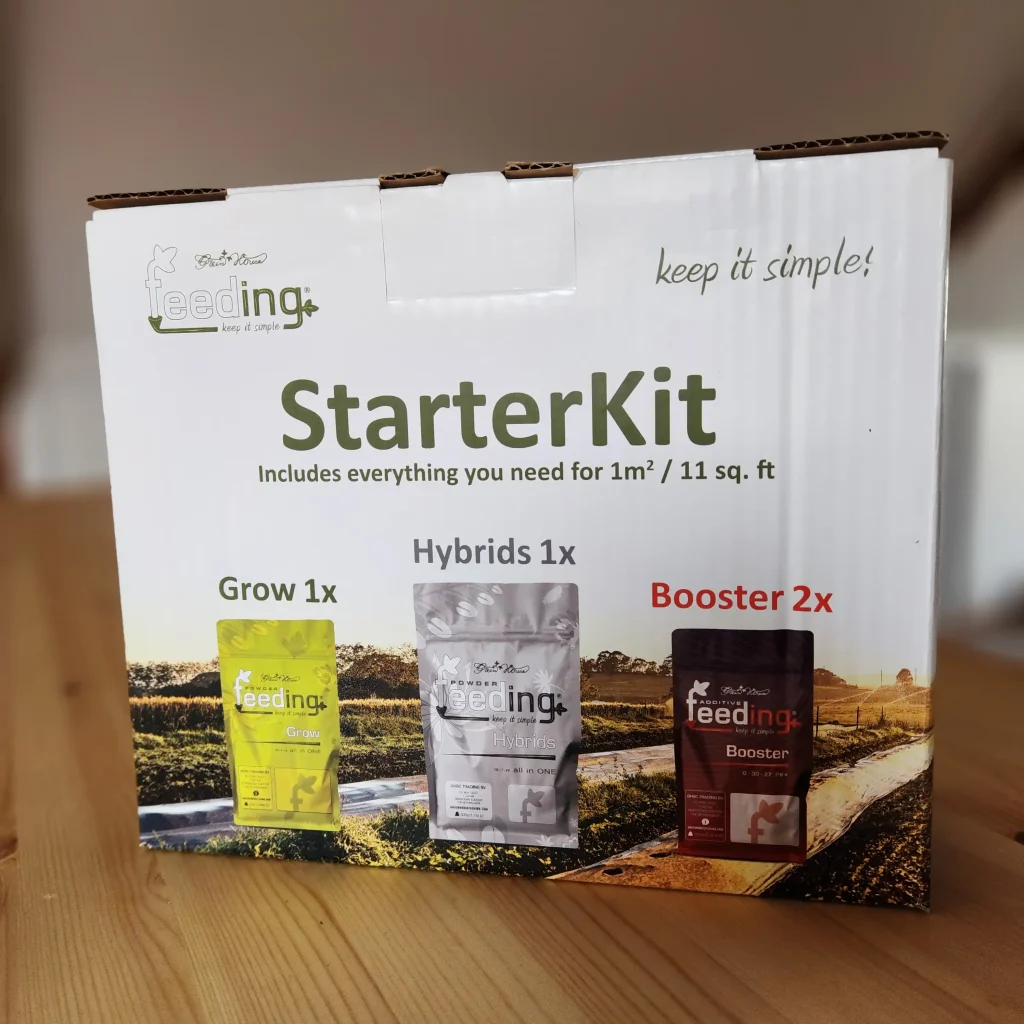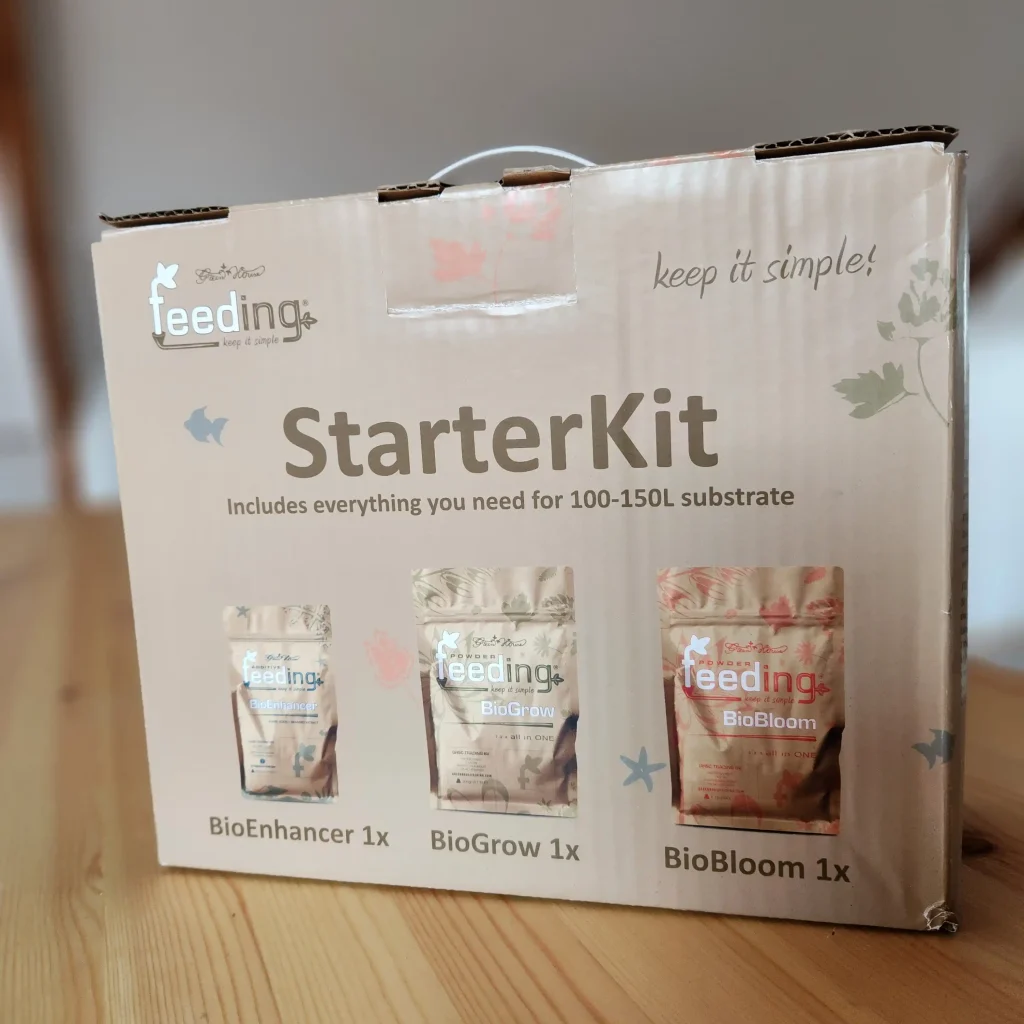Green House Feeding fertilizers are designed for cannabis cultivation and are focused on ease of use, high concentration, and effectiveness. An important part of the company’s ecosystem, they were developed with a focus on mineral and organic formulas to simplify the growing process without sacrificing quality.

Green House Feeding fertilizers are available in powder form, making them easy to store, transport, and use, and offering a longer shelf life than liquid fertilizers. The main ingredients are sourced from Germany and Switzerland, where high quality standards are maintained.
Green House Feeding offers a range of high-quality fertilizers designed for various plants, including cannabis, tomatoes, and vegetables. Developed by Green House Seeds, these products cater to both mineral and organic growing methods, ensuring robust plant development across all growth stages. This guide explores the Mineral Line and Organic Line (Bio Feeding), detailing their composition, applications, benefits, and considerations for growers. Whether you’re a beginner or an experienced cultivator, these fertilizers simplify nutrition while maximizing yield and quality.

Mineral Line: All-in-One Nutrient Solutions
The Mineral Line by Green House Feeding provides complete, water-soluble nutrient formulas containing essential macro- and micro-elements, such as nitrogen (N), phosphorus (P), potassium (K), magnesium, calcium, and sulfur. These products are ideal for hydroponics, coco coir, and soil, delivering fast nutrient uptake. For optimal results, maintain a pH of 5.8–6.2 in hydroponic systems and monitor electrical conductivity (EC) to prevent nutrient buildup. Since these formulas lack calcium, growers using soft water (e.g., reverse osmosis or rainwater) should add a calcium supplement. Alternate with plain water to avoid salt accumulation.
Grow
Composition: NPK 24-6-12, high in nitrogen, with magnesium, sulfur, and micro-elements (e.g., iron, manganese).
Purpose: Designed for the vegetative stage, supporting leaf and stem growth, mother plants, and healthy cuttings. Suitable for all plant types, it promotes continuous growth and strong roots.
Application: Use 0.5 g/L for seedlings and 0.8–1 g/L for mature plants. In soil, apply 5–7 g per 10 liters; in hydroponics, combine with calcium (1.13 g/gallon for rockwool). Continue for 1–2 weeks into early flowering. For foliar spraying, dilute further.
Benefits: Encourages rapid green mass development and prevents nitrogen deficiency (yellowing leaves, stunted growth). Cost-effective, covering the entire vegetative phase with one product.
Considerations: Avoid overuse during flowering to prevent excessive stretching. Reduce dosage in hard water to prevent nutrient lockout.
Hybrid
Composition: NPK 15-7-22, balanced with reduced ammonium nitrogen and increased magnesium, plus sulfates for essential oils.
Purpose: Tailored for hybrid varieties (50/50 indica/sativa) with an 8–9-week flowering period, supporting both growth and bloom in hydroponics.
Application: Apply 0.7–1 g/L during flowering and 0.5 g/L for seedlings. Combine with Booster (0.56 g/gallon Hybrid + 0.28 g/gallon Booster) and increase dosage weekly.
Benefits: Enhances terpene, flavonoid, and essential oil production, improving flavor and aroma. Ideal for coco and rockwool, reducing magnesium deficiency risks.
Considerations: Not suitable for pure sativas due to their longer cycles. Monitor EC (1.5–2.0 mS/cm) to avoid overfeeding.
Short Flowering and Fast Flowering
Composition: NPK 12-14-24, rich in potassium with phosphorus and micro-elements for root development.
Purpose: Formulated for short-flowering hybrids (indica, autoflowers, <8 weeks), ensuring dense buds and uniform ripening.
Application: Use 0.5–0.7 g/L in vegetative stages and 0.7–1 g/L in flowering, adding Booster (0.2–0.5 g/L). For autoflowers, use throughout the cycle. In soil, apply 7–10 g per 10 liters.
Benefits: Boosts yield and prevents potassium deficiency (uneven ripening, weak stems). Simplifies feeding for autoflowers with a single product.
Considerations: Add calcium for soft water. Flush 1–2 weeks before harvest to remove excess salts.
Long Flowering
Composition: NPK 18-12-18, balanced with high phosphorus for roots and nitrogen for extended flowering.
Purpose: Suited for long-flowering sativas (>9–10 weeks), maintaining nitrogen levels and supporting robust root systems.
Application: Use 0.6–1 g/L, increasing to 1 g/L during flowering. In hydroponics, combine with Booster late in the cycle.
Benefits: Prevents weakening during late flowering and strengthens roots for larger plants.
Considerations: Avoid for short cycles due to excess nitrogen. Monitor pH in hydroponic setups.
Booster
Composition: NPK 0-30-27, a phosphorus-potassium (PK) booster with magnesium, no nitrogen.
Purpose: Enhances flowering by increasing yield, bud density, and resin production.
Application: Add 0.2–0.5 g/L mid-flowering (3–7 g per 10 liters with base nutrients). Avoid during vegetative growth.
Benefits: Boosts yield by 20–30% and accelerates flowering.
Considerations: Overuse can cause toxicity. Use only with base formulas like Hybrid or Short Flowering.
Calcium
Composition: NPK 6-0-0, chelated calcium.
Purpose: Prevents calcium deficiency (blossom-end rot, weak leaves) in soft water setups.
Application: Add 0.1–0.2 g/L with Mineral Line nutrients. In hydroponics, use 0.17 g/gallon.
Benefits: Stabilizes pH and strengthens cell walls for healthier plants.
Considerations: Avoid mixing with other CalMag products to prevent reactions. Use only with soft water.
Organic Line (Bio Feeding): Natural Nutrition for Soil
The Organic Line, or Bio Feeding, is 100% organic, designed for soil and coco coir. These fertilizers combine natural ingredients (bone meal, horn, seaweed) to stimulate soil microbiology, including beneficial fungi and bacteria. Nutrients release gradually over 8 weeks, enhancing flavor and aroma. Not suitable for hydroponics. Maintain soil pH between 6.0–7.0 for best results.
BioGrow
Composition: NPK 7-2-4, organic nitrogen from bone meal and horn, with micro-elements.
Purpose: Supports vegetative growth, promoting strong roots, leaves, and soil microbiota for rapid development.
Application: Mix 2–3 g/L of substrate at planting. For mother plants, apply as top-dressing every 2 months. Use half the dose for seedlings.
Benefits: Builds healthy roots, increases disease resistance, and delivers organic flavor.
Considerations: Reduce dosage in pre-fertilized substrates. Nutrient release takes 8 weeks.
BioBloom
Composition: NPK 4-9-9, organic phosphorus and potassium from bone meal and winery pomace, with 18% organic carbon, 8% CaO, and 4% MgO.
Purpose: Enhances flowering, boosting yield, flavor, and aroma while supporting soil microbiology.
Application: Mix 2–3 g/L of substrate before flowering, with top-dressing mid-cycle. Ideal for 8-week flowering periods.
Benefits: Provides natural phosphorus and potassium release, forms humus, and increases resin and terpene production.
Considerations: Effectiveness depends on soil microbes, requiring proper temperature and moisture. Certified for organic cultivation.
BioEnhancer
Composition: Blend of humic acids, seaweed extracts, Trichoderma harzianum, and Bacillus subtilis.
Purpose: Improves nutrient uptake, protects roots, and boosts growth throughout the plant cycle.
Application: Use 0.5–1 g/L of water every 2 weeks for root or foliar feeding. For cuttings/seeds, apply 1 g/L. Use within 24 hours of mixing.
Benefits: Enhances microbiota, increases pathogen resistance, and improves yield. Versatile for roots, leaves, and soil.
Considerations: Do not store mixed solutions, as bacteria lose activity. Pairs well with BioGrow and BioBloom.
Starter Kits and Supplements
Bio Starter Kit: Includes BioEnhancer (125 g), BioGrow (500 g), and BioBloom (500 g), sufficient for 100–150 liters of substrate across multiple cycles. Ideal for beginners, mix with soil for a complete organic cycle. Includes a catalog and bottle. Offers cost savings, simplicity, and organic certification.
BioRoot Protector: A microbial supplement (Trichoderma, Bacillus) for protection against root pathogens like fungi and bacteria. Apply during early stages via irrigation or substrate for root rot prevention. Strengthens plant immunity and complements the Bio Line.
Why Choose Green House Feeding?
Green House Feeding fertilizers are globally trusted, available in growshops and through online retailers with fast worldwide shipping. Popular among growers, they earn 4–5 star ratings on platforms like GrowDiaries and THCFarmer for ease of use and reliable results. Suitable for cannabis and other crops, these products emphasize eco-friendliness (Organic Line) and simplicity («Keep it Simple!»). The brand offers a nutrient calculator on its website for tailored feeding schedules. Beginners should start with half doses to avoid overfeeding, and growers using hard water must monitor EC to prevent nutrient lockout.
For hydroponic setups, choose the Mineral Line for fast nutrient delivery. For organic soil growing, opt for the Bio Feeding Line to enhance flavor and sustainability. Always test on a small scale before full application to ensure compatibility with your setup.